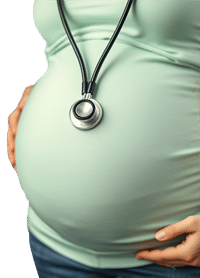
Labour is a natural process that brings you one step closer to meeting your baby. While the process can be intense, understanding the symptoms and knowing how to manage labour pain can give you plenty of confidence.
Labour Signs & Delivery Types | What To Expect As Birth Nears
Labour Signs & Delivery Types | What To Expect As Birth Nears
Learn how to tell true labour from Braxton Hicks and explore delivery options—from vaginal birth to C-section.
Labour pain symptoms include back pain, contractions, pelvic pressure, tightening, mucus plug loss, water breaking, and increased rectal pressure, signaling labour is near.

Timing and intensity of contractions are two important factors in recognising true labour from false labour pain. Let us understand what true and false labour are.
True Labour Pain
True labour pain symptoms include regular contractions that get closer together and last 30-70 seconds. You may also experience your water breaking, which may confirm that true labour has begun.
False Labour Pain
False labour pain symptoms are irregular, weaker, and often stop with movement. Moreover, this pain is usually felt only in the front of the abdomen.
Braxton Hicks contractions are mild, irregular “practice contractions” that help your body prepare for true labour. These include a gentle tightening or hardening in the abdomen, usually without a regular pattern.
Top tips for Labour & Delivery

Easy Labour
Start oil massages from the seventh month to ease labour.

Stay active
Keep practising regular prenatal exercises like deep breathing, yoga and moderate walking.

Contraction care
Practice deep breathing and visualization techniques to stay focused during contractions.

Prep for labour
Explore different positions such as walking or squatting to find movement that supports you.

Support circle
Labour can be demanding, surround yourself with loved ones for support and encouragement.

Labor check-up
If your labour feels abnormal let the doctor examine you first for a correct diagnosis

Childbirth prep
Enrol yourself in prenatal courses to learn different labour stages and what to expect.
Normal delivery pain is unique to each mother, starting with mild contractions that intensify as labor progresses. Many describe it as deep cramping or pressure.

How Does Labour Pain Start?
Labour pain usually starts with uterine contractions that become more frequent and intense. These contractions may begin in the lower back or abdomen and gradually spread as labour progresses.
What Does Labour Pain Feel Like?
Labour pain often feels like intense, rhythmic cramping that starts in the lower back and radiates to the front. For many, it’s similar to strong menstrual cramps but grows in intensity.
How To Manage Pain?
There are several ways to manage labour pain. Deep breathing helps with focus, while an exercise ball or gentle movement can relieve lower back pain. Warm showers and soothing music offer comfort and reassurance.
Pain management techniques help control and ease labor discomfort, including deep breathing, movement, using an exercise ball, or anything that feels good.

Breathing Techniques
Deep breathing involves taking slow, deep breaths. Paced breathing focuses on inhaling through the nose and exhaling slowly.
Exercise Ball
Sitting or gently bouncing on an exercise ball during labour helps relieve pressure, encourages better posture, and supports a comfortable position.
Music
Calming music provides a soothing background that helps distract from contractions and keeps you relaxed.
Movement
Gentle movement during labour, such as walking or swaying, helps relieve tension and encourages the baby’s descent.
Delivery can broadly be divided into three categories based on the process and the involvement of the medical team. They are:

Vaginal delivery: The most common type, where labour progresses naturally, often supported by pain management techniques.
Caesarean delivery: A surgical procedure, either planned or done when medical circumstances require an alternative to vaginal delivery.
Assisted vaginal delivery: Uses tools like forceps or a vacuum to help guide the baby out when additional assistance is needed.
Normal delivery is the first of delivery category where minimal to no involvement is needed from the medical team.

A normal delivery is the most common and natural way of bringing a baby into the world. It generally allows for a quicker recovery and encourages bonding with the baby right after birth.
Here are a few tips to incorporate into your routine to increase your chances of a normal delivery.
Stay active: Light exercises like walking, swimming, and prenatal yoga improve endurance.
Balanced diet: Eat a nutritious, well-rounded diet to support your body and baby’s growth.
Stay hydrated: Drinking plenty of water helps prevent fatigue and supports good circulation.
Squats and pelvic tilts: Strengthen your pelvic muscles and help the baby move into the optimal position.
Epidural for Painless Delivery
An epidural blocks pain during normal delivery through a lower spine injection. Discuss its safety with your doctor before going into labour so you can have a smoother childbirth experience.
Episiotomy Stitches
An episiotomy is a surgical incision made during delivery to help the baby pass through more easily. Episiotomy stitches close the incision and support healing. Recovery typically takes a few weeks, but proper hygiene, rest, and care can promote faster healing and comfort.
C-section is the second category of delivery where the doctor and the medical team facilitate the childbirth. Let's understand it better.

C-section is a surgical procedure where the baby is delivered through an incision in the mother’s abdomen and uterus. It can be a personal choice or recommended for specific medical conditions or unforeseen complications during delivery.
The indication of caesarean section could include factors like the baby’s position, maternal health conditions, or prolonged labour. Doctors assess these indicators before opting for a caesarean section.
There are several types of caesarean sections, each tailored to specific medical or personal circumstances.
The number of stitches used depends on whether it is a continuous stitch or several individual ones. Generally, 6-8 layers of tissue are sutured, which may require 10 to 15 individual stitches per layer, depending on the technique used.
Vacuum delivery is the third category of deliveries in which some medical intervention is needed. Let's understand it better.

What Is Vacuum Delivery?
In vacuum-assisted delivery, a vaccuum-based suction device with a soft or rigid cup is gently attached to the baby’s head. This allows the doctor to apply controlled pressure to guide the baby out during contractions.
Complications of Vacuum delivery
Complications of vacuum delivery can include mild swelling or bruising of the baby's scalp. This typically resolves in a few days. Small tears may occur for the mother, often requiring 2-5 stitches.
Forceps delivery also falls into the third category where some medical intervention is needed. Here is what you can expect.

What Is Forceps Delivery?
It’s a type of assisted delivery where forceps, which resemble large tongs, are carefully placed around the baby’s head and the doctor gently guides the baby out. This technique is generally used in the second stage of labour.
Need for Forceps Delivery
Forceps delivery could be required in the case of prolonged labour or concerns about the baby’s heart rate. Forceps may also be recommended if the mother is unable to push effectively.
However, it is generally discouraged due to the risk of potential temporomandibular joint (TMJ) issues in the baby.
Track your health through every trimester. Explore essential pregnancy tests.

Discover trusted advice from experts for all stages of your parenting
FAQs
Your bump may feel heavier and drop lower as the baby descends into position for birth.
During labour, your belly feels tight and firm, when contractions start, they come in waves.
Frequent Braxton Hicks can happen as your body prepares for labour, especially in the final weeks.
Pain can be managed with breathing techniques, movement, or pain relief options like epidurals.
The pain occurs as your body works hard to push the baby out, with muscles contracting intensely.
Labour pain usually comes in regular waves, growing stronger and closer together.
Yes, labour can begin while you’re asleep, waking you up as contractions intensity.
Yes, walking can help ease discomfort and speed up labour by encouraging the baby’s descent.
The five main types are vaginal delivery, assisted vaginal delivery, caesarean section (C-section), induced labour, and water birth.
SVD, or Spontaneous Vaginal Delivery, is a natural delivery without medical intervention.
The best delivery type varies based on health needs; vaginal delivery is often preferred for a quicker recovery process.
The two types of placental delivery are active (assisted) and physiological (natural) management.